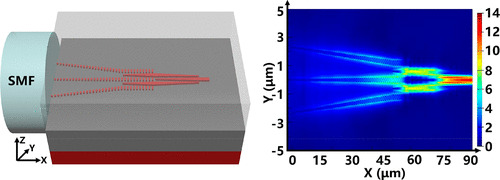当前位置:
X-MOL 学术
›
ACS Photonics
›
论文详情
Our official English website, www.x-mol.net, welcomes your feedback! (Note: you will need to create a separate account there.)
Ultracompact Fiber-to-Chip Metamaterial Edge Coupler
ACS Photonics ( IF 7 ) Pub Date : 2021-10-28 , DOI: 10.1021/acsphotonics.1c00993 An He 1 , Xuhan Guo 1 , Ting Wang 2 , Yikai Su 1
ACS Photonics ( IF 7 ) Pub Date : 2021-10-28 , DOI: 10.1021/acsphotonics.1c00993 An He 1 , Xuhan Guo 1 , Ting Wang 2 , Yikai Su 1
Affiliation

|
Compact fiber-to-chip light coupling with low loss and large bandwidth, SMF-to-chip edge coupler in particular, is extensively demanded in integrated photonics. The inescapable challenge of edge coupler is the difficulty and complexity in fabrication and packaging. During the past decades, metamaterials have manifested marvelous talent in integrated photonics. Here, we experimentally demonstrate an ultracompact edge coupler via metamaterial for SMF with a mode field diameter of 10 μm, which is fully based on silicon-on-insulator material and a CMOS compatible fabrication process. In this work, we theoretically analyze the coupling performance and the fabrication difficulty. The experimental results show that this metamaterial-based coupler possesses low coupling loss and broad bandwidth simultaneously with the coupling length of only 90 μm. At 1550 nm, the coupling losses are 2.22/2.53 dB/facet for the fundamental TE/TM mode, while the minimum average loss could reach 1.81 dB/facet. The measured bandwidth with a loss below 3 dB is as broad as 120 nm, covering the entire C/L band. Moreover, this prominently eased fabrication process potentially exhibits significant superiority in both research and industrial applications.
中文翻译:

超紧凑型光纤芯片超材料边缘耦合器
具有低损耗和大带宽的紧凑型光纤到芯片光耦合,特别是 SMF 到芯片边缘耦合器,在集成光子学中得到了广泛的需求。边缘耦合器不可避免的挑战是制造和封装的难度和复杂性。在过去的几十年里,超材料在集成光子学方面表现出了惊人的天赋。在这里,我们通过实验证明了一种超紧凑型边缘耦合器,通过超材料用于模场直径为 10 μm 的 SMF,它完全基于绝缘体上硅材料和 CMOS 兼容制造工艺。在这项工作中,我们从理论上分析了耦合性能和制造难度。实验结果表明,这种基于超材料的耦合器具有低耦合损耗和宽带宽,耦合长度仅为 90 μm。在 1550 nm 处,基本 TE/TM 模式的耦合损耗为 2.22/2.53 dB/facet,而最小平均损耗可达 1.81 dB/facet。损耗低于 3 dB 的测量带宽高达 120 nm,覆盖整个 C/L 波段。此外,这种显着简化的制造过程可能在研究和工业应用中表现出显着的优势。
更新日期:2021-11-17
中文翻译:

超紧凑型光纤芯片超材料边缘耦合器
具有低损耗和大带宽的紧凑型光纤到芯片光耦合,特别是 SMF 到芯片边缘耦合器,在集成光子学中得到了广泛的需求。边缘耦合器不可避免的挑战是制造和封装的难度和复杂性。在过去的几十年里,超材料在集成光子学方面表现出了惊人的天赋。在这里,我们通过实验证明了一种超紧凑型边缘耦合器,通过超材料用于模场直径为 10 μm 的 SMF,它完全基于绝缘体上硅材料和 CMOS 兼容制造工艺。在这项工作中,我们从理论上分析了耦合性能和制造难度。实验结果表明,这种基于超材料的耦合器具有低耦合损耗和宽带宽,耦合长度仅为 90 μm。在 1550 nm 处,基本 TE/TM 模式的耦合损耗为 2.22/2.53 dB/facet,而最小平均损耗可达 1.81 dB/facet。损耗低于 3 dB 的测量带宽高达 120 nm,覆盖整个 C/L 波段。此外,这种显着简化的制造过程可能在研究和工业应用中表现出显着的优势。



























 京公网安备 11010802027423号
京公网安备 11010802027423号